Balkans
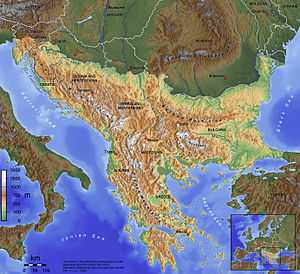 | |
| Geography | |
|---|---|
| Location | Southeast Europe |
| Area | 666,700 km2 (257,400 sq mi) |
| Highest elevation | 2,925 m (9,596 ft) |
| Highest point | Musala (Bulgaria) |
| Sovereign states | |
| Demographics | |
| Demonym | Balkan |
| Population | 40+ million |
The Balkan Peninsula, popularly referred to as the Balkans, is a geographical region of Southeast Europe.[1] The region takes its name from the Balkan Mountains that stretch from the east of Serbia to the Black Sea at the east of Bulgaria. The Balkans are generally considered to include Albania, Bulgaria, Bosnia and Herzegovina, about half of Croatia, Greece, Kosovo, the Republic of Macedonia, Montenegro, most of Serbia, and the European part of Turkey.
The region is inhabited by Albanians, Bulgarians, Bosniaks, Croats, Gorani, Greeks, Macedonians, Montenegrins, Serbs, Slovenes, Romanians, Aromanians, Turks, and other ethnic groups which present minorities in certain countries like the Romani and Ashkali.[2] The largest religion on the Balkans is Orthodox Christianity, followed by Catholic Christianity and Islam.[3]
The total area of the Balkans is 666,700 square km (257,400 square miles) and the population is 59,297,000 (est. 2002).[2] The Balkans meets the Adriatic Sea on the northwest, Ionian Sea on the southwest, the Mediterranean and Aegean Sea on the south and southeast, and the Black Sea on the east and northeast. The highest point of the Balkans is mount Musala 2,925 metres (9,596 ft) on the Rila mountain range in Bulgaria.
The Balkans have been inhabited since the Paleolithic and are the route by which farming from the Middle East spread to Europe during the Neolithic (7th millennium BC).[4][5] The Balkans are also the location of Europe's first advanced civilizations, beginning with the Bronze Age in Greece around 3200 BC.[6]
Name
Classical Antiquity
The region was referred to in Greek and Roman sources as the "Peninsula of Haemus". The mountain range itself was known as the "Haemus Mountains", the name being of possibly Thracian etymology.[7] Other possible etymology for "Haemus" (Αἵμος) comes from the Greek mythology. 'Haemus', still being used in Modern Greek, derives from the Greek word "haema" (αἵμα) meaning 'blood'. The myth goes about the fight of Zeus and the monster/titan Typhon. Zeus injured Typhon with a thunder bolt and Typhon's blood fell on the mountains from which they got their name.[8]
Early Middle Ages
The name Balkan was brought to the region in the 7th century by the Bulgars who applied it to the area, as a part of their First Bulgarian Empire. In Bulgarian language the word balkan (балкан) means "mountain".[9] At this time the name Balkan may have derived to Bulgarian from the Persian bālkāneh or bālākhāna, meaning "high, above, or proud house."[10] The name is still preserved in Central Asia with the Balkan Daglary (Balkan Mountains)[11] and the Balkan Province of Turkmenistan.
Late Middle Ages
During the Ottoman rule of the area from 1396 to 1878 it was called in Turkish "a chain of wooded mountains" (balkan).[12][13]
Current
On a larger scale, the mountains are only one part of a long continuous chain crossing the region in the form of a reversed letter S, from the Carpathians south to the Balkan range proper, before marching away east into Turkey. The Balkan Mountains include the Stara Planina (Old Mountain) mountain range in Bulgaria and part of Serbia. On the west coast, an offshoot of the Dinaric Alps follows the coast south through Dalmatia and Albania, crosses Greece, and continues into the sea in the form of islands.
In the languages of the region, the peninsula is known as:
- Slavic languages:
- Bulgarian: Балкански полуостров, transliterated: Balkanski poluostrov
- Bosnian: Balkansko poluostrvo
- Croatian: Balkanski poluotok
- Macedonian: Балкански Полуостров, transliterated: Balkanski Poluostrov
- Montenegrin: Balkansko Poluostrvo
- Serbian: Балканско полуострво/Balkansko poluostrvo
- Slovene: Balkanski polotok
- Latin languages:
- Albanian: Gadishulli Ballkanik and Siujdhesa e Ballkanit
- Greek: Βαλκανική χερσόνησος, transliterated: Valkaniki hersonisos
- Turkish: Balkan Yarımadası (or alternatively: Balkanlar)
Evolution of meaning
The first attested time the name "Balkan" was used in the West for the mountain range in Bulgaria was in a letter sent in 1490 to Pope Innocent VIII by Buonaccorsi Callimaco, an Italian humanist, writer and diplomat.[14] English traveler John Morritt introduced this term into the English literature at the end of the 18th century, and other authors started applying the name to the wider area between the Adriatic and the Black Sea. The concept of the "Balkans" was created by the German geographer August Zeune in 1808.[15] During the 1820s, "Balkan became the preferred although not yet exclusive term alongside Haemus among British travelers... Among Russian travelers not so burdened by classical toponymy, Balkan was the preferred term."[16]
As time passed, the term gradually acquired political connotations far from its initial geographic meaning, arising from political changes from the late 19th century to the creation of post–World War I Yugoslavia (initially the Kingdom of Serbs, Croats and Slovenes). Zeune's goal was to have a geographical parallel term to the Italic and Iberian Peninsula, and seemingly nothing more. The gradually acquired political connotations are newer and, to a large extent, due to oscillating political circumstances.
After the dissolution of Yugoslavia beginning in June 1991, the term "Balkans" again received a negative meaning, even in casual usage (see Balkanization).
Southeast Europe
In part due to the historical and political connotations of the term "Balkans",[17] especially since the military conflicts of the 1990s, the term "Southeast Europe" is becoming increasingly popular even though it literally refers to a much larger area and thus isn't as precise.[18] A European Union initiative of 1999 is called the Stability Pact for South Eastern Europe, and the online newspaper Balkan Times renamed itself Southeast European Times in 2003.
Definitions and boundaries
The Balkan Peninsula


The Balkan Peninsula is an area of southeastern Europe surrounded by water on three sides: the Adriatic Sea to the west, the Mediterranean Sea (including the Ionian and Aegean seas) and the Marmara Sea to the south and the Black Sea to the east. Its northern boundary is often given as the Danube, Sava and Kupa Rivers.[19][20] The Balkan Peninsula has a combined area of about 490,000 km2 (189,000 sq mi) (slightly smaller than Spain).
Countries whose territories lie mostly within the Balkan peninsula:
-
 Albania
Albania -
 Bosnia and Herzegovina
Bosnia and Herzegovina -
 Bulgaria
Bulgaria -
 Greece (mainland and some islands in the Balkans, some islands in Western Asia)
Greece (mainland and some islands in the Balkans, some islands in Western Asia) -
 Kosovo
Kosovo -
 Macedonia
Macedonia -
 Montenegro
Montenegro -
 Serbia (larger part in the Balkans, smaller in Central Europe)
Serbia (larger part in the Balkans, smaller in Central Europe)
Countries that lie partially within the Balkan peninsula:
-
 Romania (Smaller part, commonly placed in Eastern Europe or Southeast Europe)
Romania (Smaller part, commonly placed in Eastern Europe or Southeast Europe) -
 Turkey (Smaller part, commonly placed in Western Asia or Southeast Europe)
Turkey (Smaller part, commonly placed in Western Asia or Southeast Europe) -
 Italy (Minor part, placed in South Europe)
Italy (Minor part, placed in South Europe) -
 Croatia (Minor part, placed in Southeast Europe or Central Europe)
Croatia (Minor part, placed in Southeast Europe or Central Europe) -
 Slovenia (Minor part, placed in Central Europe)
Slovenia (Minor part, placed in Central Europe)
As of 1920 until World War II Italy included Istria and some Dalmatian areas (like Zara, known as Zadar) that are within the general definition of the Balkan peninsula. The current territory of Italy includes only the small area around Trieste and Gorizia inside the Balkan Peninsula. However, the regions of Trieste and Istria are not usually considered part of the Balkans by Italian geographers, due to a definition of the Balkans that limits its western border to the Kupa River.[21]
The Balkans
The abstracted term "The Balkans" covers those countries which lie within the boundaries of the Balkan Peninsula.[19] Before 1991, the whole of Yugoslavia was considered to be part of the Balkans.[22] The term "The Balkans" is sometimes used to describe only the areas in the Balkan peninsula: Moesia, Macedonia, Thrace, Kosovo, Šumadija, Bosnia, Herzegovina, Thessaly, Epirus, Peloponnese and others, but often it includes Croatia, Serbia and Romania,[19] namely the provinces of Vojvodina, Banat, Wallachia, Moldavia, Transylvania, and others. Italy as a totality is generally accepted as part of Western Europe and the Apennines. The term "the Balkans" was coined by August Zeune in 1808.
Broadly interpreted, the term Balkans comprise the following territories:[23]
-
 Albania (28,748 km2)
Albania (28,748 km2) -
 Bosnia and Herzegovina (51,197 km2)
Bosnia and Herzegovina (51,197 km2) -
 Bulgaria (110,993 km2)
Bulgaria (110,993 km2) -
 Croatia (56,594 km2)
Croatia (56,594 km2) -
 Greece (131,990 km2)
Greece (131,990 km2) -
 Kosovo (10,887 km2)
Kosovo (10,887 km2) -
 Macedonia (25,713 km2)
Macedonia (25,713 km2) -
 Montenegro (13,812 km2)
Montenegro (13,812 km2) -
 Romania (238,391 km2)
Romania (238,391 km2) -
 Slovenia (20,273 km2)
Slovenia (20,273 km2) -
 Serbia (77,474 km2)
Serbia (77,474 km2) -
 Turkey (23,764 km2)
Turkey (23,764 km2)
Western Balkans
Some institutions and member states of the European Union have defined the "Western Balkans" as the south-east European area that includes countries that are not members of the European Union, while others refer to the geographical aspects. Countries of the western Balkans are Croatia (now an EU member), Serbia, Bosnia and Herzegovina, Montenegro, Kosovo, Macedonia and Albania — or Albania plus the former Yugoslavia, minus Slovenia.[24][25][26][27][28][29][30][31] Each of these countries aims to join the EU and reach democracy and transmission scores but, until then, they will be strongly connected with the pre-EU waiting program CEFTA.[32]
Nature and natural resources

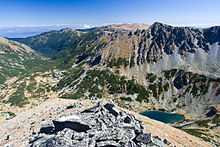

Most of the area is covered by mountain ranges running from north-west to south-east. The main ranges are the Balkan mountains, running from the Black Sea Coast in Bulgaria to its border with Serbia, the Rhodope mountains in southern Bulgaria and northern Greece, the Dinaric Alps in Bosnia and Herzegovina, Croatia and Montenegro, the Šar massif which spreads from Albania to Macedonia, and the Pindus range, spanning from southern Albania into central Greece and the Albanian Alps. The highest mountain of the region is Rila in Bulgaria, with Musala at 2925 m, Mount Olympus in Greece, the throne of Zeus, being second at 2917 m and Vihren in Bulgaria being the third at 2914 m. The karst field or polje is a common feature of the landscape.
On the Adriatic and Aegean coasts the climate is Mediterranean, on the Black Sea coast the climate is humid subtropical and oceanic, and inland it is humid continental. In the northern part of the peninsula and on the mountains, winters are frosty and snowy, while summers are hot and dry. In the southern part winters are milder. The humid continental climate is predominant in Bosnia and Herzegovina, northern Croatia, Bulgaria, Kosovo, Macedonia, northern Montenegro, the interior of Albania, Romania and Serbia, while the other, less common climates, the humid subtropical and oceanic climates, are seen on the Black Sea coast of Bulgaria and Turkey; and the Mediterranean climate is seen on the coast of Albania, coast of Croatia, Greece, southern Montenegro and the Aegean coast of Turkey.
During the centuries many woods have been cut down and replaced with bush. In the southern part and on the coast there is evergreen vegetation. Inland there are woods typical of Central Europe (oak and beech, and in the mountains, spruce, fir and pine). The tree line in the mountains lies at the height of 1800–2300 m. The landscape provides habitats for numerous endemic species, including extraordinarily abundant insects and reptiles that serve as food for a variety of birds of prey and rare vultures.
The soils are generally poor, except on the plains where areas with natural grass, fertile soils and warm summers provide an opportunity for tillage. Elsewhere, land cultivation is mostly unsuccessful because of the mountains, hot summers and poor soils, although certain cultures such as olives and grapes flourish.
Resources of energy are scarce, except in the territory of Kosovo, where considerable coal, lead, zinc, chromium, silver deposits are located.[33] Other deposits of coal, especially in Romania, Bulgaria, Serbia and Bosnia also exist. Lignite deposits are widespread in Greece. Petroleum is most notably present in Romania, although scarce reserves exist in Greece, Serbia and Albania. Natural gas deposits are scarce. Hydropower is in wide use, with over 1,000 dams. The often relentless bora wind is also being harnessed for power generation.
Metal ores are more usual than other raw materials. Iron ore is rare but in some countries there is a considerable amount of copper, zinc, tin, chromite, manganese, magnesite and bauxite. Some metals are exported.
The time zones are situated as follows:
- Territories in the time zone of UTC+01:00: Albania, Bosnia and Herzegovina, Kosovo, Macedonia, Montenegro and Serbia
- Territories in the time zone of UTC+02:00: Bulgaria, Greece, Romania and Turkey
History and geopolitical significance
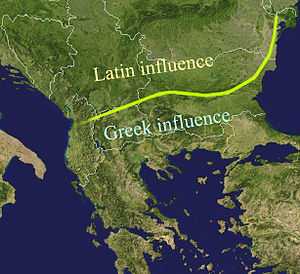

Antiquity
The Balkan region was the first area of Europe to experience the arrival of farming cultures in the Neolithic era. The practices of growing grain and raising livestock arrived in the Balkans from the Fertile Crescent by way of Anatolia and spread west and north into Pannonia and Central Europe.
The identity of the Balkans is dominated by its geographical position; historically the area was known as a crossroads of cultures. It has been a juncture between the Latin and Greek bodies of the Roman Empire, the destination of a massive influx of pagan Bulgars and Slavs, an area where Orthodox and Catholic Christianity met,[34] as well as the meeting point between Islam and Christianity.
In pre-classical and classical antiquity, this region was home to Greeks, Illyrians, Paeonians, Thracians, Dacians, and other ancient groups. The Achaemenid Persian Empire incorporated parts of the Balkans comprising Macedonia, Thrace, Bulgaria, and the Black Sea coastal region of Romania between the late 6th and the first half of the 5th century BC into its territories.[35] Later the Roman Empire conquered most of the region and spread Roman culture and the Latin language, but significant parts still remained under classical Greek influence. The Romans considered the Rhodope Mountains to be the northern limit of the Peninsula of Haemus and the same limit applied approximately to the border between Greek and Latin use in the region (later called the Jireček Line).[36] The Bulgars and Slavs arrived in the 6th century and began assimilating and displacing already-assimilated (through Romanization and Hellenization) older inhabitants of the northern and central Balkans, forming the Bulgarian Empire.[37] During the Middle Ages, the Balkans became the stage for a series of wars between the Byzantine Roman and the Bulgarian Empires.
Early modern period
By the end of the 16th century, the Ottoman Empire had become the controlling force in the region after expanding from Anatolia through Thrace to the Balkans. Many people in the Balkans place their greatest folk heroes in the era of either the onslaught or the retreat of the Ottoman Empire. As examples, for Greeks, Constantine XI Palaiologos and Kolokotronis; and for Serbs, Miloš Obilić and Tzar Lazar; for Montenegrins, Đurađ I Balšić and Ivan Crnojević; for Albanians, George Kastrioti Skanderbeg; for ethnic Macedonians, Nikola Karev[38] and Goce Delčev;[38] and for Bulgarians, Vasil Levski, Georgi Sava Rakovski and Hristo Botev.
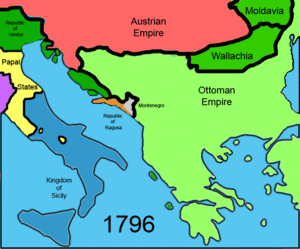
In the past several centuries, because of the frequent Ottoman wars in Europe fought in and around the Balkans and the comparative Ottoman isolation from the mainstream of economic advance (reflecting the shift of Europe's commercial and political centre of gravity towards the Atlantic), the Balkans has been the least developed part of Europe. According to Suraiya Faroqhi and Donald Quataert, "The population of the Balkans, according to one estimate, fell from a high of 8 million in the late 16th century to only 3 million by the mid-eighteenth. This estimate is in harmony with the first findings based on Ottoman documentary evidence."[39]
Most of the Balkan nation-states emerged during the 19th and early 20th centuries as they gained independence from the Ottoman Empire or the Austro-Hungarian empire (Greece in 1821, Serbia, Montenegro and Romania in 1878, Bulgaria in 1908, Albania in 1912).
20th century

World wars
In 1912–1913 the First Balkan War broke out when the nation-states of Bulgaria, Serbia, Greece and Montenegro united in an alliance against the Ottoman Empire. As a result of the war, almost all remaining European territories of the Ottoman Empire were captured and partitioned among the allies. Ensuing events also led to the creation of an independent Albanian state. Bulgaria insisted on its status quo territorial integrity, divided and shared by the Great Powers next to the Russo-Turkish War (1877–78) in other boundaries and on the pre-war Bulgarian-Serbian agreement. Provoked by the backstage deals between its former allies Serbia and Greece on allocation the spoils at the end of the First Balkan War, while it fights at the main Thracian Front, Bulgaria marks the beginning of Second Balkan War when attacked them. The Serbs and the Greeks repulse single attacks, but when the Greek army invaded Bulgaria together with an unprovoked Romanian intervention in the back, regardless of the single won battles, Bulgaria collapsed. The Ottoman Empire also used the opportunity to recapture Eastern Thrace, establishing its new western borders that still stand today.
The First World War was sparked in the Balkans in 1914 when Mlada Bosna, a revolutionary organization with predominately Serbian and pro-Yugoslav members, assassinated the Austro-Hungarian heir Archduke Franz Ferdinand of Austria in Bosnia and Herzegovina's capital, Sarajevo. That caused a war between the two countries which—through the existing chains of alliances—led to the First World War. The Ottoman Empire soon joined the Central Powers becoming one of the three empires participating in that alliance. The next year Bulgaria joined the Central Powers attacking Serbia, which was successfully fighting Austro-Hungary to the north for a year. That led to Serbia's defeat and the intervention of the Entente in the Balkans which sent an expeditionary force to establish a new front, the third one of that war, which soon also became static. The participation of Greece in the war three years later, in 1918, on the part of the Entente finally altered the balance between the opponents leading to the collapse of the common German-Bulgarian front there, which caused the exit of Bulgaria from the war, and in turn the collapse of the Austro-Hungarian Empire, ending the First World War.[40]
With the start of the Second World War all Balkan countries, with the exception of Greece, were allies of Nazi Germany, having bilateral military agreements or being part of the Axis Pact. Fascist Italy expanded the war in the Balkans by using its protectorate Albania to invade Greece. After repelling the attack, the Greeks counterattacked, invading Italy-held Albania and causing Nazi Germany's intervention in the Balkans to help its ally.[41] Days before the German invasion a successful coup d'état in Belgrade by neutral military personnel seized power.[42]
Although the new government reaffirmed Serbia's intentions to fulfill its obligations as member of the Axis,[43] Germany, using its other two allied countries in the region, Bulgaria and Hungary, invaded both Greece and Yugoslavia. Yugoslavia immediately disintegrated when those loyal to the Serbian King and the Croatian units mutinied.[44] Greece resisted, but, after two months of fighting, collapsed and was occupied. The two countries were partitioned between the three Axis allies, Bulgaria, Germany and Italy, and the Independent State of Croatia, a puppet state of Italy and Germany.
During the occupation the population suffered considerable hardship due to repression and starvation, to which the population reacted by creating a mass resistance movement.[45] Together with the early and extremely heavy winter of that year (which caused hundreds of thousands deaths among the poorly fed population), the German invasion had disastrous effects in the timetable of the planned invasion in Russia causing a significant delay,[46] which had major consequences during the course of the war.[47]
Finally, at the end of 1944, the Soviets entered Romania and Bulgaria forcing the Germans out of the Balkans. They left behind a region largely ruined as a result of wartime exploitation, but by making use of the post-war separation of Germany into two independent entities, the German states successfully and legally avoided paying any reparations or repaying the forced loans given by the occupied countries.
Cold War
During the Cold War, most of the countries on the Balkans were governed by communist governments. Greece became the first battleground of the emerging Cold War. The Truman Doctrine was the US response to the civil war, which raged from 1944 to 1949. This civil war, unleashed by the Communist Party of Greece, backed by communist volunteers from neighboring countries (Albania, Bulgaria and Yugoslavia), led to massive American assistance for the non-communist Greek government. With this backing, Greece managed to defeat the partisans and, ultimately, remained the only non-communist country in the region.
However, despite being under communist governments, Yugoslavia (1948) and Albania (1961) fell out with the Soviet Union. Yugoslavia, led by Marshal Josip Broz Tito (1892–1980), first propped up then rejected the idea of merging with Bulgaria and instead sought closer relations with the West, later even spearheaded, together with India and Egypt the Non-Aligned Movement. Albania on the other hand gravitated toward Communist China, later adopting an isolationist position.
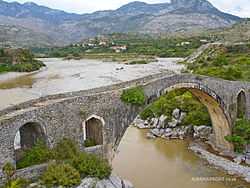
As the only non-communist countries, Greece and Turkey were (and still are) part of NATO composing the southeastern wing of the alliance.
Post–Cold War
In the 1990s, the transition of the regions' ex-Soviet bloc countries towards democratic free-market societies went peacefully with the exception of Yugoslavia. Wars between the former Yugoslav republics broke out after Slovenia and Croatia held free elections and their people voted for independence on their respective countries' referenda. Serbia in turn declared the dissolution of the union as unconstitutional and the Yugoslavian army unsuccessfully tried to maintain status quo. Slovenia and Croatia declared independence on 25 June 1991, followed by the Ten-Day War in Slovenia. Till October 1991, the Army withdrew from Slovenia, and in Croatia, the Croatian War of Independence would continue until 1995. In the ensuing 10 years armed confrontation, gradually all the other Republics declared independence, with Bosnia being the most affected by the fighting. The long lasting wars resulted in a United Nations intervention and NATO ground and air forces took action against Serb forces in Bosnia and Herzegovina and Serbia.
From the dissolution of Yugoslavia six republics achieved international recognition as sovereign republics, but these are traditionally included in Balkans: Croatia, Bosnia and Herzegovina, Macedonia, Montenegro and Serbia. In 2008, while under UN administration, Kosovo declared independence (according to the official Serbian policy, Kosovo is still an internal autonomous region). In July 2010, the International Court of Justice, ruled that the declaration of independence was legal.[48] Most UN member states recognise Kosovo. After the end of the wars a revolution broke in Serbia and Slobodan Milošević, the Serbian communist leader (elected president between 1989 and 2000), was overthrown and handed for trial to the International Criminal Tribunal for crimes against the International Humanitarian Law during the Yugoslav wars. Milošević died of a heart attack in 2006 before a verdict could have been released. Ιn 2001 an Albanian uprising in Macedonia forced the country to give local autonomy to the ethnic Albanians in the areas where they predominate.
With the dissolution of Yugoslavia an issue emerged over the name under which the former (federated) republic of Macedonia would internationally be recognized, between the new country and Greece. Being the Macedonian part of Yugoslavia (see Vardar Macedonia), the federated Republic under the Yugoslav identity had the name Republic of Macedonia on which it declared its sovereignty in 1991. Greece, having a large region (see Macedonia) also under the same name opposed to the usage of this name as an indication of a nationality. The issue is currently under negotiations after a UN initiation.
Balkan countries control the direct land routes between Western Europe and South West Asia (Asia Minor and the Middle East). Since 2000, all Balkan countries are friendly towards the EU and the USA.
Greece has been a member of the European Union since 1981 while Bulgaria and Romania are members since 2007. In 2005, the European Union decided to start accession negotiations with candidate countries; Turkey, and Macedonia were accepted as candidates for European Union membership. In March 2004, Bulgaria and Romania have become members of NATO. As of April 2009,[49] Albania is a member of NATO. Bosnia and Herzegovina and what was then Serbia and Montenegro started negotiations with the EU over the Stabilization and Accession Agreements, although shortly after they started, negotiations with Serbia and Montenegro were suspended for lack of co-operation with the International Criminal Tribunal for the Former Yugoslavia. During the 2008 Bucharest summit Greece vetoed Macedonia's NATO membership bid over the Macedonia naming dispute between the two countries.
All other countries have expressed a desire to join the EU at some point in the future.
Politics and economy
Currently all of the states are republics, but until World War II all except Turkey were monarchies. Most of the republics are parliamentary, excluding Romania and Bosnia which are semi-presidential. All the states have open market economies, most of which are in the upper-middle income range ($4,000 – $12,000 p.c.), however, Greece has high income economies (over $12,000 p.c.), and is also classified with very high HDI in contrast to the remaining states which are classified with high HDI. The states from the former Eastern Bloc that formerly had planned economy system and Turkey mark gradual economic growth each year, only the economy of Greece drops for 2012 and meanwhile it was expected to grow in 2013. The Gross domestic product (Purchasing power parity) per capita is highest in Greece (over $25), followed by Turkey, Bulgaria, Romania, Montenegro, Serbia, Macedonia ($10 – $15), Bosnia, Albania and Kosovo (below $10).[50] The Gini coefficient, which indicates the level of difference by monetary welfare of the layers, is on the second level at the highest monetary equality in Albania, Bulgaria and Serbia, on the third level in Greece, Montenegro and Romania, on the fourth level in Macedonia, on the fifth level in Turkey, and the most unequal by Gini coefficient is Bosnia at the eighth level which is the penultimate level and one of the highest in the world. The unemployment is lowest in Romania (below 10%), followed by Bulgaria, Turkey, Albania (10 – 15%), Greece (15 – 20%), Montenegro, Serbia, Bosnia (20 – 30%), Macedonia (over 30%) and Kosovo (over 40%).
- On political, social and economic criteria the divisions are as follows:
- Territories members of the European Union: Bulgaria, Greece and Romania
- Territories candidates for EU membership disapproved with deposited date for joining: Macedonia, Montenegro, and Turkey
- Territories which submitted application for candidate status for EU membership: Albania
- Territories considered as potential candidates for EU membership: Bosnia and Herzegovina and Kosovo
- On border control and trade criteria the divisions are as follows:
- Territories members of the Schengen Area: Greece
- Territories candidates for the Schengen Area: Bulgaria, Romania
- Territories in a customs union with the EU: Turkey
- Territories members of the Central European Free Trade Agreement: Albania, Bosnia and Herzegovina, Kosovo, Macedonia, Montenegro and Serbia.
- On currency criteria the divisions are as follows:
- Territories members of the Eurozone: Greece
- Territories using the Euro without authorization by the EU: Kosovo and Montenegro
- Territories using the national currencies and candidates for the Eurozone: Bulgaria (lev), Romania (leu)
- Territories using the national currencies: Albania (lek), Bosnia and Herzegovina (convertible mark), Macedonia (denar) and Serbia (dinar).
- On military criteria the divisions are as follows:

- Territories members of NATO: Albania, Bulgaria, Greece, Romania and Turkey
- Territories members of the Partnership for Peace with Individual Partnership Action Plan and Membership Action Plan for joining NATO: Bosnia and Herzegovina, Macedonia and Montenegro
- Territories members of the Partnership for Peace: Serbia
- On the recent political, social and economic criteria there are two groups of countries:
- Territories with communist past: Albania, Bosnia and Herzegovina, Bulgaria, Kosovo, Macedonia, Montenegro, Romania and Serbia
- Territories with capitalist past: Greece and Turkey
Regional organizations
 Southeast European Cooperation Process (SEECP) member states |  |
 |  Black Sea Economic Cooperation (BSEC) members observers |
See also the Black Sea Regional organizations
Demographics



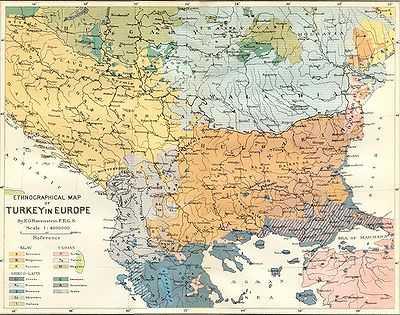

The Balkans have a population of 60–71 million and a population density of 80-91/km2, depending on whether the Turkish and Italian parts are counted within the peninsula. Without those, the peninsula has a population of about 48 million and a density of 99/km2.
Population by territories:
| Territory | Total population | In the peninsula * | Density | Life expectancy |
|---|---|---|---|---|
| 2,831,741[51] | 2,831,741[51] | 98.5/km2 | 77.4 years | |
| 3,839,737[52] | 3,839,737[52] | 75.0/km2 | 74.9 years | |
| 7,364,570[53] | 7,814,570[53] Ref. | 66.4/km2 | 73.0 years | |
| 11,123,034[54] | 11,123,034[54] | 81.7/km2 | 82 years | |
| 1,733,872[55] | 1,733,872[55] | 178.7/km2 | – | |
| 2,057,284[56] | 2,057,284[56] | 80.0/km2 | 74.2 years | |
| 625,266[57] | 625,266[57] | 45.3/km2 | – | |
| 19,042,936[58] | 832,141[58] | 90.2/km2 | 72.5 years | |
| 7,209,764[59] | 7,209,764[59]2 | 93.06/km2 | 74.2 years | |
| 76,667,864[60] | 10,620,739[61] | 447.0/km3 | 75 years[62] | |
| Balkans ** | 132,473,148 | 40,850,676 | – |
[*] The islands are not taken into account.
[***] Both census figures of Serbia and Kosovo in the table do not include North Kosovo, therefore in the population of the Balkans, made up of sum of the populations in the table, is added separately an additional number of 70,000 to include the missing population of North Kosovo.
Religion
The region's principal religions are Christianity (Eastern Orthodox, Catholic) and Islam (Sunni).[3] Eastern Orthodoxy is the majority religion in both the Balkan peninsula and the Balkan region. A variety of different traditions of each faith are practiced, with each of the Eastern Orthodox countries having its own national church.
- Territories in which the principal religion is Eastern Orthodoxy (with national churches in parentheses):
- Bulgaria (Bulgarian Orthodox Church)
- Greece (Greek Orthodox Church)
- Macedonia (Macedonian Orthodox Church)
- Montenegro (Serbian Orthodox Church and Montenegrin Orthodox Church)
- Romania (Romanian Orthodox Church)
- Serbia (Serbian Orthodox Church)
- Territories in which the principal religion is Catholicism:
- Territories in which the principal religion is Sunni Islam:
- Territories in which religious minorities encompass over 10% of the population:
- Albania: Albanian Orthodox Church and Catholicism
- Bosnia and Herzegovina: Serbian Orthodox Church and Catholicism
- Kosovo: Serbian Orthodox Church
- Macedonia: Islam
- Montenegro: Islam
- Romania: Protestantism and Catholicism (including Eastern Catholic Church)
- Territories in which religious minorities encompass less than 10% of the population:
- Serbia: Catholicism, Protestantism and Islam (mainly in Sandžak)
- Croatia: Serbian Orthodox Church and Islam
- Turkey: Catholicism and Eastern Orthodox Christianity
The Jewish communities of the Balkans were some of the oldest in Europe and date back to ancient times. These communities were Sephardi Jews, except in Romania where the Jewish communities were Ashkenazi Jews. In Bosnia and Herzegovina, the small and close-knit Jewish community is 90% Sephardic, and Ladino is still spoken among the elderly. The Sephardi Jewish cemetery in Sarajevo has tombstones of a unique shape and inscribed in ancient Ladino.[63] Sephardi Jews used to have a large presence in the city of Thessaloniki, and by 1900, some 80,000, or more than half of the population, were Jews.[64] The Jewish communities in the Balkans suffered immensely during World War II, and the vast majority were killed during the Holocaust. An exception were the Bulgarian Jews, most of whom were saved by Boris III of Bulgaria, who resisted Adolf Hitler, opposing their deportation to Nazi concentration camps. Almost all of the few survivors have emigrated to the (then) newly founded state of Israel and elsewhere. No Balkan country today has a significant Jewish minority.
Languages
The Balkan region today is a very diverse ethno-linguistic region, being home to multiple Slavic, Romance, and Turkic languages, as well as Greek, Albanian, and others. Romani is spoken by a large portion of the Romanis living throughout the Balkan countries. Throughout history many other ethnic groups with their own languages lived in the area, among them Thracians, Illyrians, Romans, Celts and various Germanic tribes. All of the aforementioned languages from the present and from the past belong to the wider Indo-European language family, with the exception of the Turkic languages (e.g., Turkish and Gagauz).
- Territories where the predominant language is from the Albanian language family:
- Albania and Kosovo
- Territories where the predominant language is from the Hellenic language family:
- Greece
- Territories where the predominant language is from the Latin language family:
- Romania
- Territories where the predominant language is from the Slavic language family:
- Bosnia and Herzegovina, Bulgaria, Macedonia, Montenegro and Serbia.
- Territories where the predominant language is from the Turkic language family:
- Turkey
- Territories in which there are minority language families encompassing over 10% of the population:
- Macedonia: Albanian language family
Urbanization
Most of the states in the Balkans are predominantly urbanized; the countries in which the rural population is the majority are Bosnia and Herzegovina and Kosovo each being about 50% rural and 50% urban.[65]

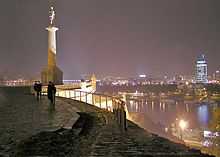
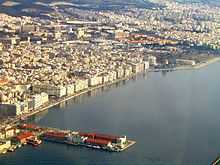

A list of cities with population of over 150,000 inhabitants:
| Rank | City | Country | Urban pop. | Metro pop. | Census |
|---|---|---|---|---|---|
| 1 | Belgrade | | 1,344,844 | 1,659,440 | 2011[66] |
| 2 | Sofia | | 1,204,685 | 1,359,520 | 2011[67] |
| 3 | Thessaloniki | | 788,952 | 1,104,460 | 2011[68] |
| 4 | Zagreb | | 686,568 | 1,107,115 | 2011[69] |
| 5 | Athens | | 664,046 | 3,737,550 | 2011[68] |
| 6 | Skopje | | 506,926 | 668,518 | 2002[70] |
| 7 | Tirana | | 418,495 | 749,365 | 2011[71] |
| 8 | Sarajevo | | 369,534 | 438,443 | 2013 (preliminary)[72] |
| 9 | Plovdiv | | 339,077 | 403,153 | 2011[67] |
| 10 | Varna | | 334,870 | 343,544 | 2011[67] |
| 11 | Ljubljana | | 282,994 | N/A | 2013[73] |
| 12 | Novi Sad | | 277,522 | 341,625 | 2011[66] |
| 13 | Burgas | | 200,271 | 223,902 | 2011[67] |
| 14 | Niš | | 183,544 | 260,237 | 2011[66] |
| 15 | Split | | 167,121 | 178,102 | 2011 |
| 16 | Patras | | 171,484 | 260,308 | 2011[68] |
| 17 | Pristina | | 161,751 | 205,133 | |
| 18 | Podgorica | | 156,196 | 189,937 | 2011[74] |
| 19 | Banja Luka | | 150,997 | 199,191 | 2013 (preliminary)[75] |
| 20 | Kragujevac | | 150,835 | 179,417 | 2011[66] |
| | |||||
| Istanbul* | | 12,919,000 | 14,160,467 | 2013[76] | |
| Constanța | | 254,693 | N/A | 2011[77] | |
| Çorlu | | 215,293 | N/A | 2010[78] | |
| Trieste | | 205,374 | N/A | 2009[79] | |
- [*] İstanbul is partly located in the Balkans, and partly in Asia.
Culture
- Cuisine of the Balkans
- Balkan music
See also
- Balkan Insight
- Balkan languages
- Balkanization
- Balkan Universities Network
- History of the Balkans
- Balkan wars
- Historical regions of the Balkan Peninsula
- Music of Southeastern Europe
- Orient Express
Annotations
- ↑ Kosovo is the subject of a territorial dispute between the Republic of Serbia and the Republic of Kosovo. The latter declared independence on 17 February 2008, but Serbia continues to claim it as part of its own sovereign territory. Kosovo's independence has been recognised by 108 out of 193 United Nations member states.
References
- ↑ Colin S. Gray, Geoffrey Sloan. Geopolitics, Geography and Strategy. Retrieved 10 November 2014.
- ↑ 2.0 2.1 Encyclopædia Britannica, Balkans
- ↑ 3.0 3.1 Okey, Robin (2007). Taming Balkan Nationalism. Oxford University Press.
- ↑ Borza, EN (1992), In the Shadow of Olympus: The Emergence of Macedon, Princeton University Press, p. 58
- ↑ Perlès, Catherine (2001), The Early Neolithic in Greece: The First Farming Communities in Europe, Cambridge University Press, p. 1
- ↑ "British Museum - Ancient Greece". Retrieved 12 September 2014.
- ↑ "Bulgaria". Hemus – a Thracian name. Indiana University. p. 54.
- ↑ "Gods and Heroes of the Greeks: The Library of Apollodorus". Google Books. Retrieved 12 September 2014.
- ↑ Андрейчин Л. и др., Български тъловен речник (допълнен и преработен от Д. Попов). Четвърто преработено и допълнено издание.: Издателство “Наука и изкуство”. С., 1994
- ↑ Todorova, Maria N. (1997). Imagining the Balkans. New York: Oxford University Press, Inc. p. 27.
- ↑ "Balkhan Mountains". World Land Features Database. Land.WorldCityDB.com. Archived from the original on 28 February 2008. Retrieved 31 March 2008.
- ↑ "Balkan". Encarta World English Dictionary. Microsoft Corporation. Archived from the original on 31 October 2009. Retrieved 31 March 2008.
- ↑ "balkan". Büyük Türkçe Sözlük (in Turkish). Türk Dil Kurumu.
Sarp ve ormanlık sıradağ
- ↑ Todorova, Maria (2009). Imagining the Balkans. Oxford University Press US. p. 22. ISBN 0-19-538786-4.
- ↑ Pavic, Silvia (22 November 2000). "Some Thoughts About The Balkans.". About, Inc. Archived from the original on 28 February 2008. Retrieved 31 March 2008.
- ↑ Maria Todorova Gutgsell, Imagining the Balkans (Oxford University Press, 2009; ISBN 0199728380), p. 24.
- ↑ "Balkanize". merriam-webster.com.
- ↑ Bideleux, Robert; Ian Jeffries (2007). A history of Eastern Europe. Taylor & Francis. p. 37. ISBN 978-0-415-36627-4.
- ↑ 19.0 19.1 19.2 Jelavich, Barbara (1983). History of the Balkans: Eighteenth and nineteenth centuries. Cambridge University Press. p. 1. ISBN 978-0-521-27458-6.
- ↑ "britannica.com". Encyclopedia Britannica. Retrieved 12 September 2014.
- ↑ Istituto Geografico De Agostini, L'Enciclopedia Geografica – Vol.I – Italia, 2004, Ed. De Agostini p.78
- ↑ Tintero, Felipa L.; Felicitas R. Manacsa. World Geography Affected by World Upheavals. Goodwill Trading Co., Inc. p. 51. ISBN 971-574-041-3.
- ↑ Bideleux, Robert; Taylor, Richard (1996). European integration and disintegration: east and west. p. 249.
- ↑ Zoltan Hajdu, ed. (2007). "The European integration and regional policy of the West Balkans". Southeast-Europe: state borders, cross-border relations, spatial structures. Ivan Illes, Zoltan Raffay. Centre for Regional Studies. p. 141. ISBN 978-963-9052-65-9. Retrieved 18 October 2014.
- ↑ "European Economic and Social Committee – Western Balkans". European Economic and Social Committee. Retrieved 12 September 2014.
- ↑ "European Union External Action – EU relations with the Western Balkans". Retrieved 12 September 2014.
- ↑ Redaktion: PT-DLR. "Federal Ministry of Education and Research of Germany – Western Balkan Countries". Retrieved 12 September 2014.
- ↑ Austrian Foreign Miniistry – The Western Balkans – A Priority of Austrian Foreign Policy
- ↑ "WBIF – Western Balkans Investment Framework – Stakeholders". Retrieved 12 September 2014.
- ↑ "European Commission – Trade – Countries and regions – Western Balkans". Retrieved 12 September 2014.
- ↑ "Western Balkans: Enhancing the European Perspective" (PDF). Communication from the Commission to the European Parliament and the Council. 5 March 2008. Archived (PDF) from the original on 9 April 2008. Retrieved 8 April 2008.
- ↑ "Perspectives on the Region" (PDF). Retrieved 19 July 2013.
- ↑ "Regions and territories: Kosovo". BBC News. 20 November 2009. Archived from the original on 15 April 2010. Retrieved 17 April 2010.
- ↑ Goldstein, I. (1999). Croatia: A History. McGill-Queen's University Press.
- ↑ Joseph Roisman,Ian Worthington A Companion to Ancient Macedonia pp 342-345 John Wiley & Sons, 7 jul. 2011 ISBN 144435163X
- ↑ Boundary between Greek and Latin
- ↑ Twenty Years of Balkan Tangle. Mary Edith Durham (2007). p.125. ISBN 1-4346-3426-4
- ↑ 38.0 38.1 Considered a Bulgarian in Bulgaria
- ↑ An economic and social history of the Ottoman Empire. Suraiya Faroqhi, Donald Quataert (1997). Cambridge University Press. p.652. ISBN 0-521-57455-2
- ↑ Encyclopedia of World War I, Spencer Tucker, Priscilla Mary Roberts, p.242
- ↑ Europe in Flames, J. Klam, 2002, p.41
- ↑ Russia's life-saver, Albert Loren Weeks, 2004, p.98
- ↑ Germany and the 2nd World War Volume III:The Mediterranean, south-east Europe, and north Africa, 1939–1941, Gerhard Schreiber, Bernd Stegemann, Detlef Vogel, 1995, p.484
- ↑ Germany and the 2nd World War Volume III:The Mediterranean, south-east Europe, and north Africa, 1939–1941, Gerhard Schreiber, Bernd Stegemann, Detlef Vogel, 1995, p.521
- ↑ Inside Hitler's Greece:The Experience of Occupation, Mark Mazower, 1993
- ↑ Hermann Goring: Hitler's Second-In-Command, Fred Ramen, 2002, p.61
- ↑ The encyclopedia of codenames of World War II#Marita, Christopher Chant, 1986, p.125-6
- ↑ "Kosovo independence declaration deemed legal". Reuters. 22 July 2010. Retrieved 16 February 2014.
- ↑ Ceremony marks the accession of Albania to NATO, NATO – News, 7 April 2009. Retrieved 18 April 2009.
- ↑ "Report for Selected Countries and Subjects". International Monetary Fund. 2009–2016.
- ↑ 51.0 51.1 "Institute of Statistics of Albania. 2011 Census Results".
- ↑ 52.0 52.1 Agency for Statistics of Bosnia and Herzegovina. Estimate for 2011.
- ↑ 53.0 53.1 "National Statistical Institute of Bulgaria. 2011 Census Results".
- ↑ 54.0 54.1 http://epp.eurostat.ec.europa.eu/tgm/table.do?tab=table&init=1&language=en&pcode=tps00001&plugin=1 Official estimate
- ↑ 55.0 55.1 "Statistical Office of Kosovo. 2011 Census Results".
- ↑ 56.0 56.1 "State Statistical Office of Macedonia. Estimate for 2010" (PDF) (in Macedonian). Retrieved 17 April 2010.
- ↑ 57.0 57.1 "Statistical Office of Montenegro. 2011 Census Results".
- ↑ 58.0 58.1 "National Institute of Statistics of Romania. 2011 Census Results." (PDF) (in Romanian).
- ↑ 59.0 59.1 "Statistical Office of Serbia. 2011 Census Results".
- ↑ "Turkish Statistical Institute".
- ↑ "Turkish Statistical Institute. Registered population as of 2011".
- ↑ "OECD Better Life Index".
- ↑ European Jewish Congress – Bosnia-Herzegovina, Accessed 15 July 2008.
- ↑ "Greece". Jewish Virtual Library.
- ↑ "Data: Urban population (% of total)". The World Bank. 2006–2010.
- ↑ 66.0 66.1 66.2 66.3 "2011 Census of Population, Households and Dwellings in the Republic of Serbia: Comparative Overview of the Number of Population in 1948, 1953, 1961, 1971, 1981, 1991, 2002 and 2011, Data by settlements" (PDF). Statistical Office of Republic Of Serbia, Belgrade. 2014. ISBN 978-86-6161-109-4. Retrieved 2014-06-27.
- ↑ 67.0 67.1 67.2 67.3 "ПРЕБРОЯВАНЕ 2011" (PDF) (in Bulgarian). National Statistical Institute of Bulgaria. 2011.
- ↑ 68.0 68.1 68.2 "Πίνακας 1: Προσωρινά αποτελέσματα του Μόνιμου Πληθυσμού της Ελλάδος: Ανακοίνωση προσωρινών αποτελεσμάτων Απογραφής Πληθυσμού 2011" (PDF) (in Greek). National Statistical Service of Greece. 2011.
- ↑ "Popisane osobe, kućanstva i stambene jednice, prvi rezultati popisa 2011 (Grad Zagreb)" (in Croatian). Croatian Bureau of Statistics. 2011.
- ↑ Government of the Republic of Macedonia. "2002 census results" (PDF). stat.gov.mk. Retrieved 2010-01-30.
- ↑ "Population and Housing Census in Albania" (PDF). Institute of Statistics of Albania. 2011.
- ↑ "Census 2013 preliminary" (PDF). Statistical office of Republika Srpska. 2013.
- ↑ "Statistical Yearbook Ljubljana 2013". Place Names. City Administration, Department for Development and Investments. Retrieved 18 August 2014.
- ↑ "Montenegrin 2011 census". Monstat. 2011.
- ↑ "2013 census (preliminary)" (PDF). Statistical office of Republika Srpska. 2013.
- ↑ "The Results of Address Based Population Registration System, 2013". Turkish Statistical Institute. 31 December 2013. Retrieved 29 January 2014.
- ↑ "COMISIA JUDEŢEANǍ PENTRU RECENSĂMÂNTUL POPULAŢIEI ŞI AL LOCUINŢELOR, JUDEŢUL CONSTANTA" (PDF) (in Romanian). National Institute of Statistics of Romania. 2011.
- ↑ "Turkey: Registered Population". List of the registered population by cities and provinces in the years 2010 and 2007, quoted from the State Institute of Statistics of the Republic of Turkey. City Population DE. 2010.
- ↑ "ISTAT". National Institute of Statistics of Italy. 2009.
Sources
- Gray, Colin S. (1999). Geopolitics, Geography and Strategy. London, United Kingdom: Routledge. ISBN 978-0-7146-8053-8.
- Banac, Ivo (October 1992). "Historiography of the Countries of Eastern Europe: Yugoslavia". American Historical Review (University of Chicago Press) 97 (4): 1084–1104. doi:10.2307/2165494. JSTOR 2165494.
- Banac, Ivo (1984). The National Question in Yugoslavia: Origins, History, Politics. Ithaca, N.Y.: Cornell University Press. ISBN 978-0-8014-9493-2.
- Goldstein, Ivo (1999). Croatia: A History. Montreal, Quebec, Canada: McGill-Queen's University Press. ISBN 978-0-7735-2017-2.
- Carter, Francis W., ed. An Historical Geography of the Balkans Academic Press, 1977.
- Dvornik, Francis. The Slavs in European History and Civilization Rutgers University Press, 1962.
- Fine, John V. A., Jr. The Early Medieval Balkans: A Critical Survey from the Sixth to the Late Twelfth Century [1983]; The Late Medieval Balkans: A Critical Survey from the Late Twelfth Century to the Ottoman Conquest. Ann Arbor: University of Michigan Press, [1987].
- Jelavich, Barbara (29 July 1983). History of the Balkans. Cambridge University Press.
- Jelavich, Charles and Jelavich, Barbara, eds. (1963). The Balkans in Transition: Essays on the Development of Balkan Life and Politics Since the Eighteenth Century. University of California Press.
- Kitsikis, Dimitri (2008). La montée du national-bolchevisme dans les Balkans. Le retour à la Serbie de 1830. Paris: Avatar.
- Lampe, John R., and Marvin R. Jackson; Balkan Economic History, 1550–1950: From Imperial Borderlands to Developing Nations Indiana University Press, 1982
- Király, Béla K., ed. East Central European Society in the Era of Revolutions, 1775–1856. 1984
- Komlos, John (15 October 1990). Economic Development in the Habsburg Monarchy and in the Successor States. East European Monographs No. 28. East European Monographs. ISBN 978-0-88033-177-7.
- Mazower, Mark (2000). The Balkans: A Short History. Modern Library Chronicles. New York: Random House. ISBN 0-679-64087-8.
- Stavrianos, L. S. (1 May 2000) [1958]. The Balkans since 1453. with Traian Stoianovich. New York: NYU Press. ISBN 978-0-8147-9766-2.
- Stoianovich, Traian (September 1994). Balkan Worlds: The First and Last Europe. Sources and Studies in World History. New York: M.E. Sharpe. ISBN 978-1-56324-032-4.
External links
| Wikimedia Commons has media related to Balkans. |
| Wikivoyage has a travel guide for Balkans. |
| Look up balkans in Wiktionary, the free dictionary. |
| Wikiquote has quotations related to: Balkans |
| Wikisource has the text of the 1911 Encyclopædia Britannica article Balkan Peninsula. |
- SEEurope.net—news coverage on Southeastern Europe
- Southeast European Times
- Analysis from Balkans
- Photo impression
- Balkan Business News
- Balkanalysis.com- Objective Analysis, Research and News on the Balkans
| |||||||||||||||||||||||||
| |||||||||||||||||||||||||||||||||||
| ||||||||||



.svg.png)